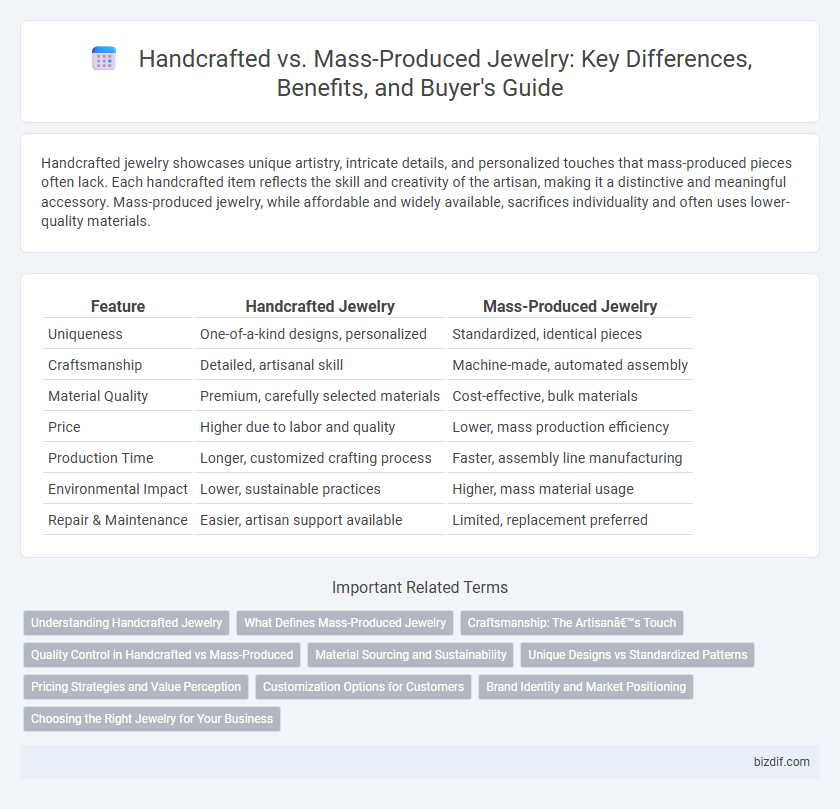Handcrafted jewelry showcases unique artistry, intricate details, and personalized touches that mass-produced pieces often lack. Each handcrafted item reflects the skill and creativity of the artisan, making it a distinctive and meaningful accessory. Mass-produced jewelry, while affordable and widely available, sacrifices individuality and often uses lower-quality materials.
Table of Comparison
| Feature | Handcrafted Jewelry | Mass-Produced Jewelry |
|---|---|---|
| Uniqueness | One-of-a-kind designs, personalized | Standardized, identical pieces |
| Craftsmanship | Detailed, artisanal skill | Machine-made, automated assembly |
| Material Quality | Premium, carefully selected materials | Cost-effective, bulk materials |
| Price | Higher due to labor and quality | Lower, mass production efficiency |
| Production Time | Longer, customized crafting process | Faster, assembly line manufacturing |
| Environmental Impact | Lower, sustainable practices | Higher, mass material usage |
| Repair & Maintenance | Easier, artisan support available | Limited, replacement preferred |
Understanding Handcrafted Jewelry
Handcrafted jewelry embodies artisanal skill and intricate detailing, reflecting unique creativity and personalized touches that mass-produced pieces lack. Each item is meticulously shaped and finished by skilled jewelers, ensuring superior quality and exclusivity. This approach results in distinctive designs that often hold greater sentimental and monetary value compared to factory-made alternatives.
What Defines Mass-Produced Jewelry
Mass-produced jewelry is characterized by its creation using automated machinery and standardized molds, allowing for high-volume output with consistent design and quality. This process significantly reduces production costs and time, making pieces widely available and affordable. Unlike handcrafted jewelry, mass-produced items lack unique artisanal details and are often made from lower-cost materials to prioritize efficiency over individuality.
Craftsmanship: The Artisan’s Touch
Handcrafted jewelry showcases impeccable craftsmanship through intricate detailing and unique designs that reflect the artisan's expertise and creativity. Each piece is meticulously shaped, polished, and finished by skilled hands, ensuring superior quality and distinctiveness compared to mass-produced items. The artisan's touch imbues handcrafted jewelry with character and authenticity, making every creation a wearable work of art.
Quality Control in Handcrafted vs Mass-Produced
Handcrafted jewelry undergoes meticulous quality control at each stage, ensuring unique finishes and structural integrity tailored to individual pieces. Mass-produced jewelry relies heavily on automated inspections and standardized processes, which can result in uniformity but may overlook subtle defects or craftsmanship nuances. The personalized attention in handcrafted production often leads to superior durability and aesthetic appeal compared to mass-produced counterparts.
Material Sourcing and Sustainability
Handcrafted jewelry often utilizes ethically sourced, high-quality materials, prioritizing sustainable practices and reducing environmental impact through small-batch production. Mass-produced jewelry commonly relies on large-scale suppliers, which can involve less transparency in material sourcing and contribute to resource depletion and waste. Sustainable jewelry making favors artisans who select recycled metals and conflict-free gemstones, ensuring eco-friendly and socially responsible products.
Unique Designs vs Standardized Patterns
Handcrafted jewelry showcases unique designs crafted with meticulous attention to detail, often reflecting the artisan's creativity and individuality. In contrast, mass-produced jewelry relies on standardized patterns to achieve uniformity and cost efficiency, limiting variations in design. Consumers seeking personalized or one-of-a-kind pieces typically prefer handcrafted items over mass-produced alternatives.
Pricing Strategies and Value Perception
Handcrafted jewelry often commands higher prices due to its uniqueness, artisanal skill, and limited production, which enhances perceived value and exclusivity. Mass-produced jewelry benefits from economies of scale, allowing lower pricing that appeals to budget-conscious consumers but may lack the emotional and aesthetic appeal of handcrafted pieces. Pricing strategies for handcrafted items emphasize quality and craftsmanship, while mass-produced pricing centers on affordability and accessibility.
Customization Options for Customers
Handcrafted jewelry offers extensive customization options, allowing customers to select unique materials, designs, and personal engravings that reflect individual style and meaning. In contrast, mass-produced pieces typically provide limited or no customization, focusing on standardized designs to streamline production and reduce costs. The personalized nature of handcrafted jewelry enhances its value and emotional significance for the wearer, setting it apart from mass-produced alternatives.
Brand Identity and Market Positioning
Handcrafted jewelry cultivates a unique brand identity emphasizing artisanal skill, exclusivity, and personalized craftsmanship, which appeals to niche markets seeking authentic and distinctive pieces. Mass-produced jewelry, on the other hand, leverages scalability and affordability, positioning brands in broader, mainstream markets focused on trend-based designs and accessibility. The choice between handcrafted and mass-produced production directly influences brand perception, customer loyalty, and competitive market positioning within the jewelry industry.
Choosing the Right Jewelry for Your Business
Handcrafted jewelry offers unique designs, superior craftsmanship, and the ability to customize pieces, making it ideal for businesses seeking exclusivity and brand differentiation. Mass-produced jewelry provides cost efficiency, consistent inventory levels, and faster turnaround times, suited for retailers aiming to meet high-demand markets. Selecting the right jewelry depends on your target audience, budget constraints, and brand positioning within the competitive jewelry industry.
Handcrafted vs Mass-produced Infographic

 bizdif.com
bizdif.com